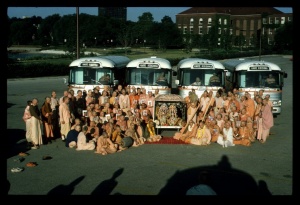SB 7.3.18: Difference between revisions
m (1 revision(s)) |
(Vanibot #0054 edit - transform synonyms into clickable links, which search similar occurrences) |
||
| (One intermediate revision by one other user not shown) | |||
| Line 1: | Line 1: | ||
{{info | {{info | ||
|speaker=Lord | |speaker=Lord Brahmā | ||
|listener= | |listener=Hiraṇyakaśipu | ||
}} | }} | ||
[[Category:Srimad-Bhagavatam - Canto 07 Chapter 03]] | |||
[[Category:Bhagavatam Verses Spoken by Lord Brahma - Vanisource|070318]] | |||
<div style="float:left">'''[[Srimad-Bhagavatam]] - [[SB 7|Seventh Canto]] - [[SB 7.3: Hiranyakasipu's Plan to Become Immortal|Chapter 3: Hiraṇyakaśipu's Plan to Become Immortal]]'''</div> | |||
<div style="float:right">[[File:Go-previous.png|link=SB 7.3.17]] '''[[SB 7.3.17]] - [[SB 7.3.19]]''' [[File:Go-next.png|link=SB 7.3.19]]</div> | |||
{{RandomImage}} | |||
==== TEXT 18 ==== | ==== TEXT 18 ==== | ||
<div | <div class="verse"> | ||
adrākṣam aham etaṁ te | :adrākṣam aham etaṁ te | ||
hṛt-sāraṁ mahad-adbhutam | :hṛt-sāraṁ mahad-adbhutam | ||
daṁśa-bhakṣita-dehasya | :daṁśa-bhakṣita-dehasya | ||
prāṇā hy asthiṣu śerate | :prāṇā hy asthiṣu śerate | ||
</div> | </div> | ||
| Line 17: | Line 22: | ||
==== SYNONYMS ==== | ==== SYNONYMS ==== | ||
<div | <div class="synonyms"> | ||
''[//vanipedia.org/wiki/Special:VaniSearch?s=adrākṣam&tab=syno_o&ds=1 adrākṣam]'' — have personally seen; ''[//vanipedia.org/wiki/Special:VaniSearch?s=aham&tab=syno_o&ds=1 aham]'' — I; ''[//vanipedia.org/wiki/Special:VaniSearch?s=etam&tab=syno_o&ds=1 etam]'' — this; ''[//vanipedia.org/wiki/Special:VaniSearch?s=te&tab=syno_o&ds=1 te]'' — your; ''[//vanipedia.org/wiki/Special:VaniSearch?s=hṛt&tab=syno_o&ds=1 hṛt]-[//vanipedia.org/wiki/Special:VaniSearch?s=sāram&tab=syno_o&ds=1 sāram]'' — power of endurance; ''[//vanipedia.org/wiki/Special:VaniSearch?s=mahat&tab=syno_o&ds=1 mahat]'' — very great; ''[//vanipedia.org/wiki/Special:VaniSearch?s=adbhutam&tab=syno_o&ds=1 adbhutam]'' — wonderful; ''[//vanipedia.org/wiki/Special:VaniSearch?s=daṁśa&tab=syno_o&ds=1 daṁśa]-[//vanipedia.org/wiki/Special:VaniSearch?s=bhakṣita&tab=syno_o&ds=1 bhakṣita]'' — eaten by worms and ants; ''[//vanipedia.org/wiki/Special:VaniSearch?s=dehasya&tab=syno_o&ds=1 dehasya]'' — whose body; ''[//vanipedia.org/wiki/Special:VaniSearch?s=prāṇāḥ&tab=syno_o&ds=1 prāṇāḥ]'' — the life air; ''[//vanipedia.org/wiki/Special:VaniSearch?s=hi&tab=syno_o&ds=1 hi]'' — indeed; ''[//vanipedia.org/wiki/Special:VaniSearch?s=asthiṣu&tab=syno_o&ds=1 asthiṣu]'' — in the bones; ''[//vanipedia.org/wiki/Special:VaniSearch?s=śerate&tab=syno_o&ds=1 śerate]'' — is taking shelter. | |||
</div> | </div> | ||
| Line 24: | Line 29: | ||
==== TRANSLATION ==== | ==== TRANSLATION ==== | ||
<div | <div class="translation"> | ||
I have been very much astonished to see your endurance. In spite of being eaten and bitten by all kinds of worms and ants, you are keeping your life air circulating within your bones. Certainly this is wonderful. | I have been very much astonished to see your endurance. In spite of being eaten and bitten by all kinds of worms and ants, you are keeping your life air circulating within your bones. Certainly this is wonderful. | ||
</div> | </div> | ||
| Line 31: | Line 36: | ||
==== PURPORT ==== | ==== PURPORT ==== | ||
<div | <div class="purport"> | ||
It appears that the soul can exist even through the bones, as shown by the personal example of Hiraṇyakaśipu. When great yogīs are in samādhi, even when their bodies are buried and their skin, marrow, blood and so on have all been eaten, if only their bones remain they can exist in a transcendental position. Very recently an archaeologist published findings indicating that Lord Christ, after being buried, was exhumed and that he then went to Kashmir. There have been many actual examples of yogīs' being buried in trance and exhumed alive and in good condition several hours later. A yogī can keep himself alive in a transcendental state even if buried not only for many days but for many years. | It appears that the soul can exist even through the bones, as shown by the personal example of Hiraṇyakaśipu. When great ''yogīs'' are in ''samādhi'', even when their bodies are buried and their skin, marrow, blood and so on have all been eaten, if only their bones remain they can exist in a transcendental position. Very recently an archaeologist published findings indicating that Lord Christ, after being buried, was exhumed and that he then went to Kashmir. There have been many actual examples of ''yogīs''' being buried in trance and exhumed alive and in good condition several hours later. A ''yogī'' can keep himself alive in a transcendental state even if buried not only for many days but for many years. | ||
</div> | </div> | ||
__NOTOC__ | |||
<div style="float:right; clear:both;">[[File:Go-previous.png|link=SB 7.3.17]] '''[[SB 7.3.17]] - [[SB 7.3.19]]''' [[File:Go-next.png|link=SB 7.3.19]]</div> | |||
__NOTOC__ | |||
__NOEDITSECTION__ | |||
Latest revision as of 23:00, 18 February 2024

A.C. Bhaktivedanta Swami Prabhupada
TEXT 18
- adrākṣam aham etaṁ te
- hṛt-sāraṁ mahad-adbhutam
- daṁśa-bhakṣita-dehasya
- prāṇā hy asthiṣu śerate
SYNONYMS
adrākṣam — have personally seen; aham — I; etam — this; te — your; hṛt-sāram — power of endurance; mahat — very great; adbhutam — wonderful; daṁśa-bhakṣita — eaten by worms and ants; dehasya — whose body; prāṇāḥ — the life air; hi — indeed; asthiṣu — in the bones; śerate — is taking shelter.
TRANSLATION
I have been very much astonished to see your endurance. In spite of being eaten and bitten by all kinds of worms and ants, you are keeping your life air circulating within your bones. Certainly this is wonderful.
PURPORT
It appears that the soul can exist even through the bones, as shown by the personal example of Hiraṇyakaśipu. When great yogīs are in samādhi, even when their bodies are buried and their skin, marrow, blood and so on have all been eaten, if only their bones remain they can exist in a transcendental position. Very recently an archaeologist published findings indicating that Lord Christ, after being buried, was exhumed and that he then went to Kashmir. There have been many actual examples of yogīs' being buried in trance and exhumed alive and in good condition several hours later. A yogī can keep himself alive in a transcendental state even if buried not only for many days but for many years.